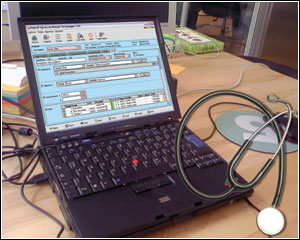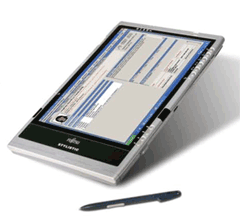Electronic Medical Records (EMR)

The Electronic Medical Records (EMR) is a software that allows the creation, storage, editing and retrieval of a patient's data on a computer. To a lesser extent it also creates Electronic/ Personal Health Records (EHR/PHR) that have been making strides around the world. Many hospitals or hospital clusters have either implemented EMRs or are in the process of doing so. Many countries around the world are looking at putting in place the infrastructure that would support EHR/PHR as well. Countries like Singapore, Australia, Taiwan, Malaysia and Hong Kong have made significant progress in both these areas.
As exciting, but often less reported, are the potential benefits such initiatives can deliver to life sciences and biomedical industry. There are significant crossover benefits that aim to deal with the industry's most vexing challenges. Two such examples are more effective identification and recruitment of clinical trial participants, and the ability to simultaneously capture clinical trial data from the electronic health record. The latter helps in decreasing the cost of clinical trials, resulting in faster time-to-market for new drugs.With the average cost of developing a new prescription drug creeping toward one billion dollars, and the process often spanning more than a decade, pharmaceutical manufacturers are continually searching for ways to extend efficiencies at all stages of the development continuum. Clinical trials - that average 124 million dollars per drug candidate, barring drug failure rates - are a prime target for scrutiny. Rising clinical trial costs can be attributed to several factors, including new challenges related to trial candidate identification and recruitment.
Clinical trial patient recruitment is also an increasingly time-consuming process. One study, which looked at 4,000 clinical trials over five years, discovered that nearly half of the time spent on the trial process involved patient, site and investigator recruitment. On average, difficulties in patient enrollment can delay 81 per cent of all clinical trials from one to six months, which costs pharmaceutical companies as much as eight million dollars each day.
This figure does not take into account the human costs of such delays in terms of the inevitable morbidity and mortality when promising new drugs are delayed in reaching the market.
Today, initiatives at individual investigation sites are revealing glimpses into the potential of patient's EMR data to transform clinical trial recruitment.
This will require biomedical and life sciences to work together in terms of information exchange. The pharmaceutical company will provide physicians, in both public and private sector, with information on the clinical trials currently being conducted, as well as the selection criteria for the trials.
The physicians, on the other hand, could refer to a patient's EMR during a routine examination to determine if the patient meets eligibility requirement for a particular clinical trial. If a patient matches the criteria, the physician could immediately collect the additional information required for the trial from the patient, record the data in the EMR and send it to an electronic notification to the relevant party. This way, screening for the trial is completed within a matter of minutes.
By combining electronic health records with data mining tools, pharmaceutical companies can also have the potential to quickly query the EMR database to determine the number of potential candidates for a specific study, and to assess the viability of candidates for a specific trial. They can also quickly screen large numbers of anonymous electronic records for potential trial candidates using any number of factors, including age, sex, co-morbidities and lab results. In this way, pharmaceutical companies could approach physician groups that they know treat significant numbers of patients matching a specific trial candidate profile.
This method could be particularly useful when recruiting for trials for drugs intended to treat rare conditions, since the trial sponsor from the pharmaceutical or biomedical company could efficiently search for specific criteria. The end result could be faster and more cost-effective, ultimately accelerating time-to-market.
While the approach outlined above would enable more effective targeting of physician practices that treat viable candidates, another approach being advanced could take information on clinical trials directly to the potential candidates. This would involve creation of a patient opt-in mechanism, in which individuals would grant permission to have life sciences organisations access their health information via the EMR. Hence, when clinical trial is being launch, the patients can be contacted directly. This approach could go a long way towards empowering patients to take charge of key health decisions, as well as streamlining the participant recruitment process. To optimise the success of this approach, physicians would also need to be notified, in tandem, when trial sponsor contacts their patients.
Once a patient is enrolled in a trial, researchers could then incorporate data captured from a specific study as part of the EMR and routine clinical care by physicians. Automating these processes can help accelerate clinical trials by streamlining patient enrollment and documentation. If all the relevant trial and medical information is available to the doctor in the form of EMR, physicians can make accurate and correct diagnosis 80 per cent of the time.

The conversion from paper records to electronic records in the healthcare system will be a complex one. Issues such as data privacy, data protection, regulation and audit have to be addressed. However, the healthcare and life sciences industries are optimistic about the potential of electronic health data to transform the delivery of healthcare, as well as the drug development process. This included spurring advances in the quest for personalised and translational treatments and therapies.
The critical technology components needed to enable meaningful exchange of information between the healthcare and life sciences industry exist today, as do the data mining and analytical tools needed to interpret data and drive incisive action. By combining these core technologies with proper planning and vision, electronic health records offer one of the brightest hopes for the future of the healthcare and life sciences industries and their quest to save and enhance the quality of lives.








